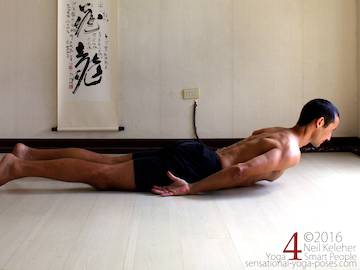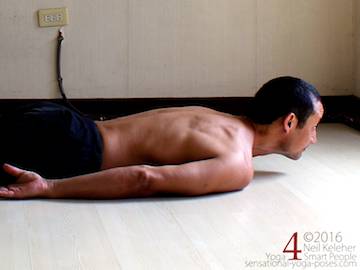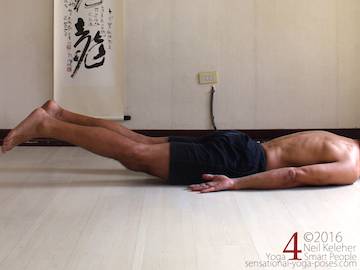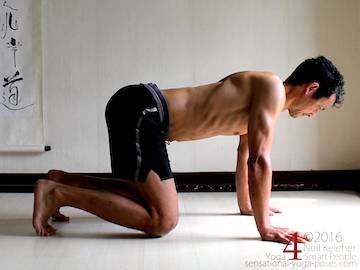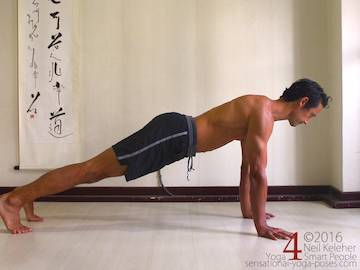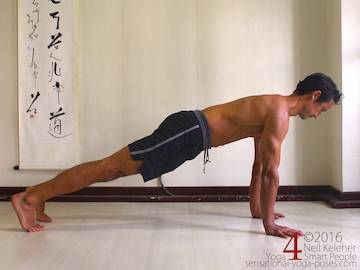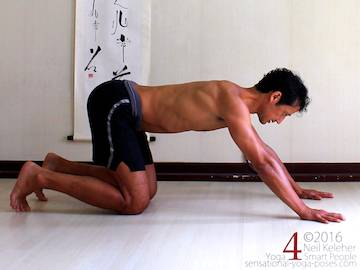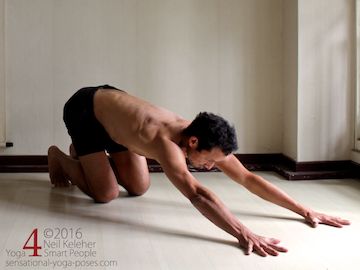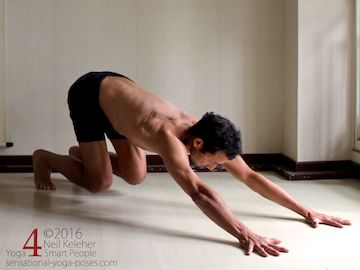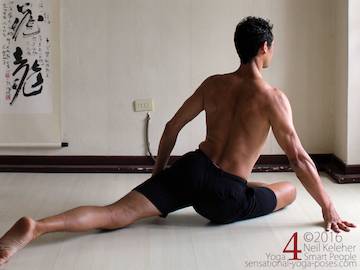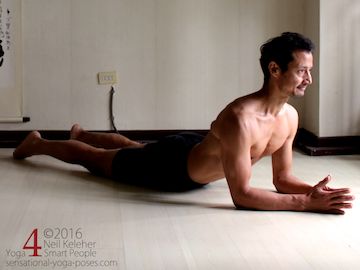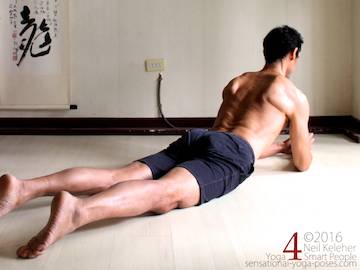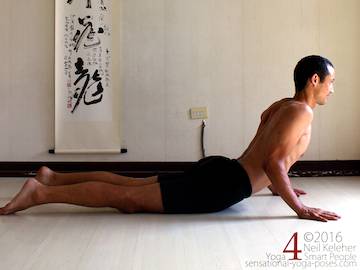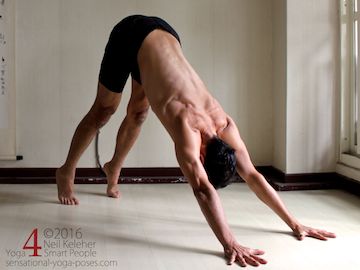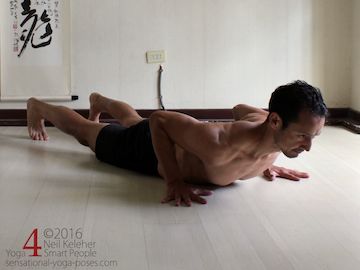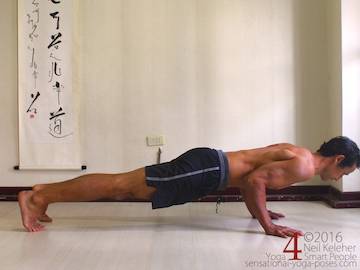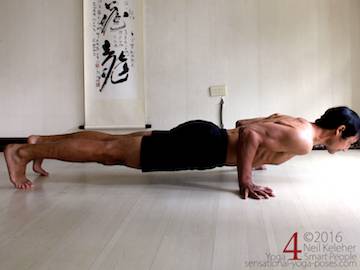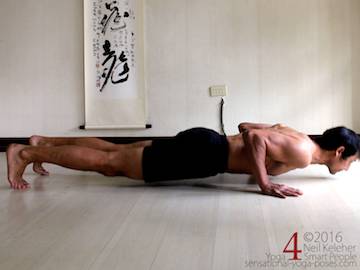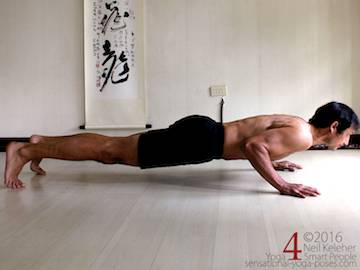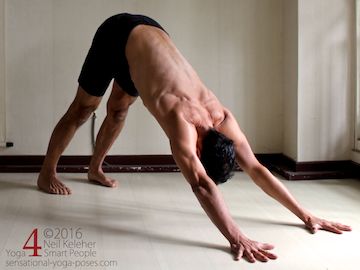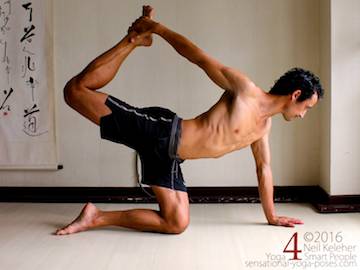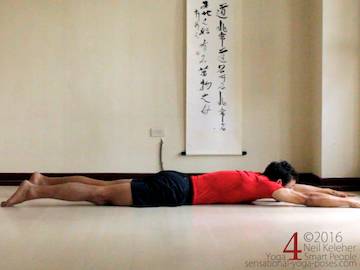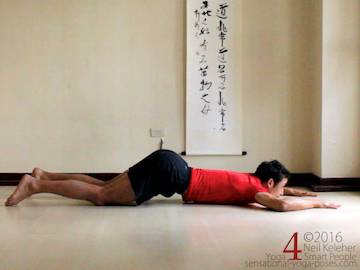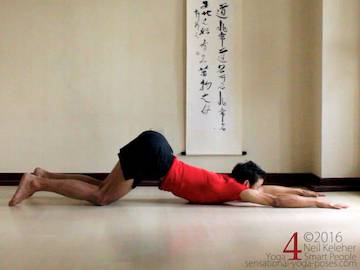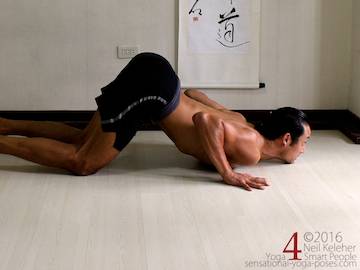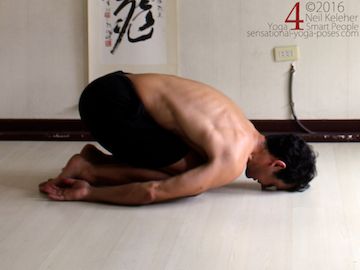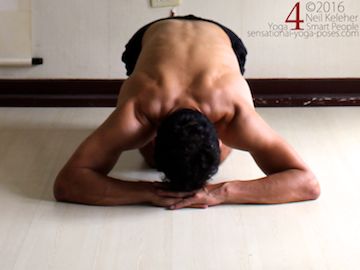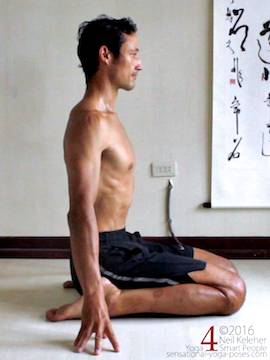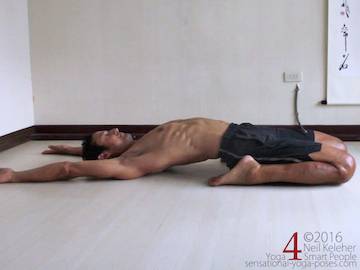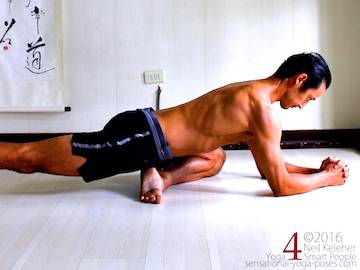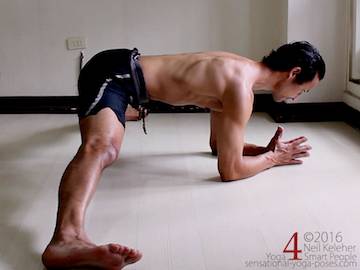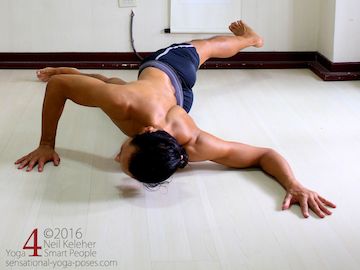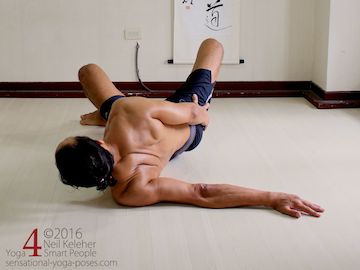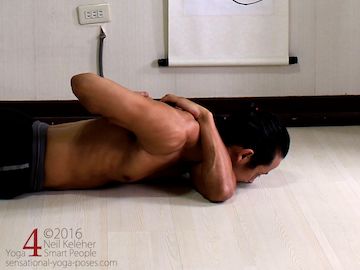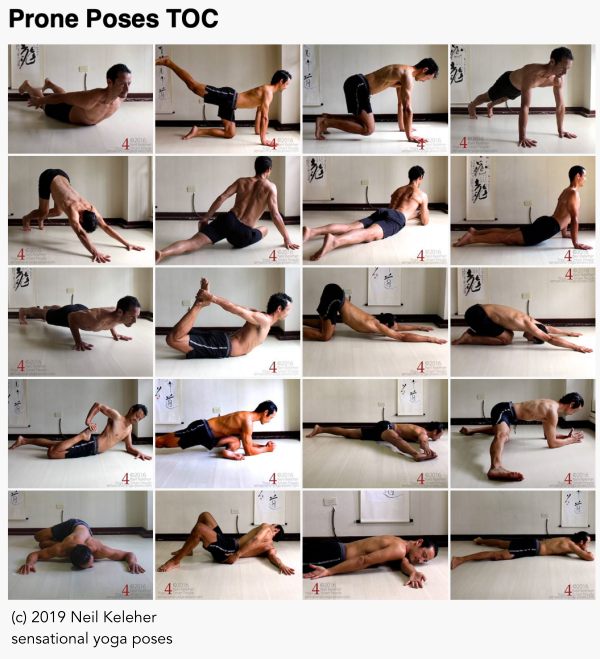Prone Poses TOC
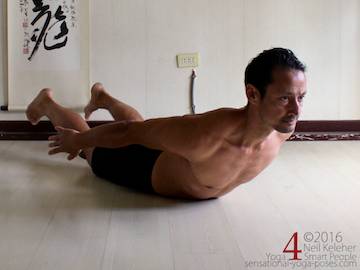
Locust pose

Extended cat pose
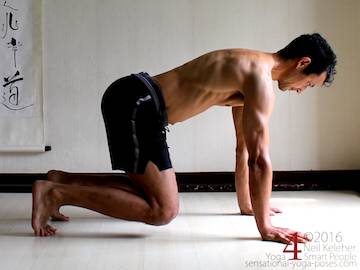
Dog pose knee lift
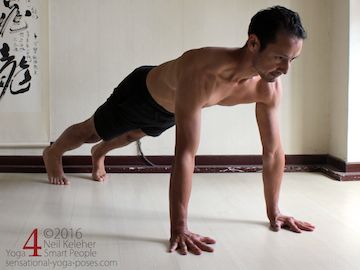
Plank pose
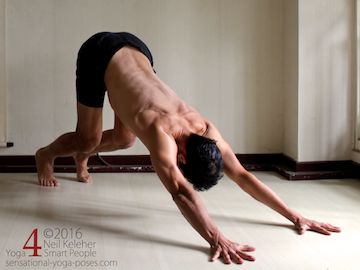
Downward dog
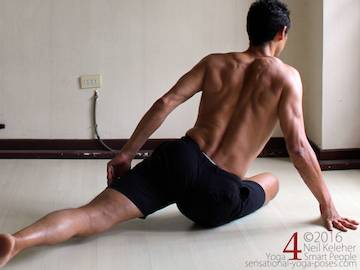
Upright pigeon
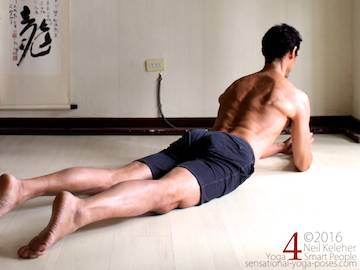
Cobra pose
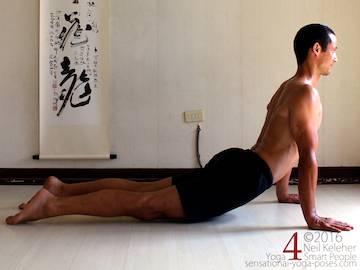
Upward dog
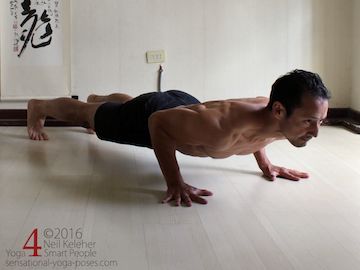
Chaturanga dandasana
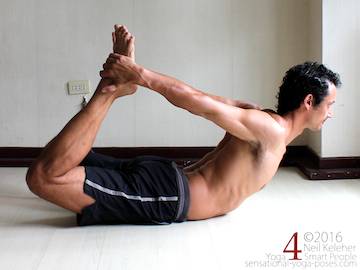
Bow pose
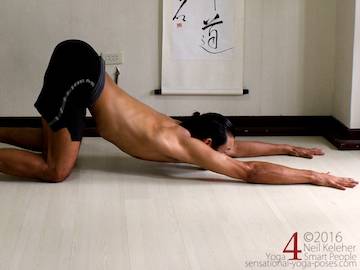
Puppy dog pose
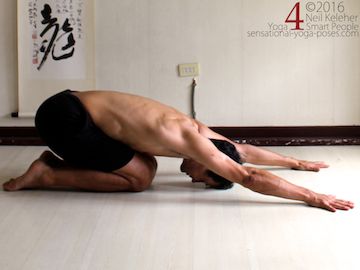
Child's pose
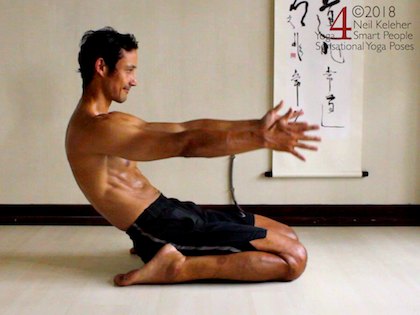
Bent back hero pose
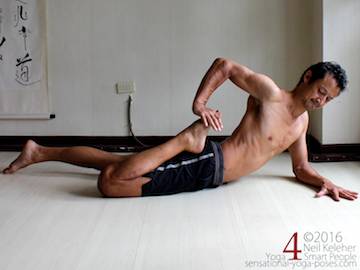
Frog pose
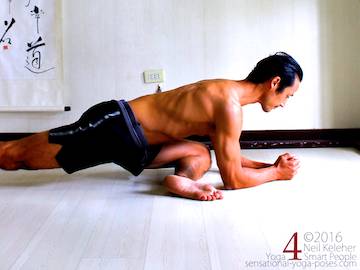
Pigeon pose
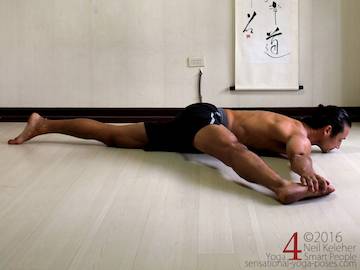
Prone big toe pose

Half side split

Prone twist
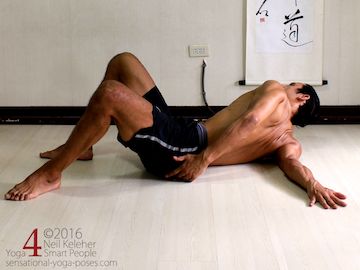
Lapasana shoulder stretch
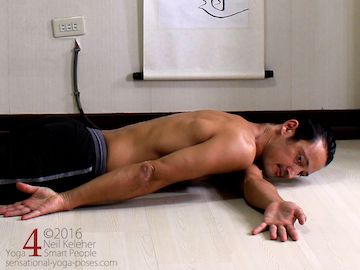
Half dragonfly arm stretch
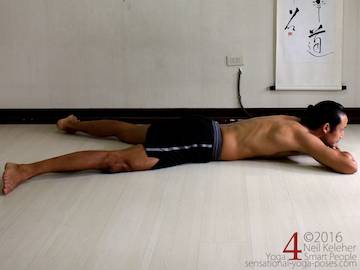
Prone resting poses
Related
Backbending (and Strengthening) Prone Yoga Poses
These first three variations of locust pose could be used as a way to gently warm up your awareness. For the first exercise lift your head without lifting your chest or shoulders. Bend your neck backwards. Hold, or lift and lower a few times.
Prior to lifting your chest lift your head but this time keep the neck straight. Work at bending your thoracic spine backwards using your spinal erectors.
On all fours (belly is still facing downwards) pull your tailbone towards your head (so that your pubic bone moves back between your legs) and bend your lumbar and thoracic spine backwards. Lift one leg, reaching it back and up with the knee straight and pointing backwards. Make sure that your spinal erectors are active. In addition make sure that the gluteus maximus and hamstrings of the lifted leg are both active. Keep the knee pointing downwards.
Returning lying on the floor with the belly down. Press your pelvis down into the floor and lift both legs. (Alternatively, lift one leg, lower, then lift the other leg.) Hold, release and then lift both legs and ribcage. To assist the upper body lift reach your arms backwards so that your latissimus dorsai engage.
Front Bending
(And Ab Strengthening) Belly Down Poses
Return to all fours with the belly facing down. Press the fronts of your feet into the floor. Lift your knees. Prior to both actions, lift your ribcage so that your shoulder blades are spread. Hold, lower, then relax. Repeat a few times.
Press down with your hands and spread your shoulders to lift your chest. Straighten both knees and hold plank pose. For pelvis and lower back awareness move your tailbone towards your head to increase lumbar lordosis (top left) then move your pubic bone towards your chest to decrease lumbar lordosis. Try to do both actions smoothly and find the position that feels most comfortable on your lower back.
Starting on all fours with hands slightly forwards (or knees slightly back) push your chest and hips back.
Press your hands forwards to activate your shoulders, then lift your knees. See if you can lift your knees an inch or less. Lower, then return to the start and repeat a few times.
Next move into downward facing dog with knees bent and heels lifted. Focus on using your arms to push your ribcage and pelvis back, away from your hands.
More Back Bending
(And Strengthening) Prone Poses
The idea of injecting upright pigeon pose at this point is to give the arms, and the front of the body, a break. With front-leg hip on the floor and front shin parallel to the front of your mat use your front-leg arm to push your body to the back-leg side. Activate your spinal erectors and the gluteus maximus and hamstrings of the rear leg. Additionally push down with your front knee.
Return to lying prone on your belly but with your chest propped up by your elbows. Pull your elbows back against the floor to pull your chest forwards. Try to spread your shoulder blades to prevent winged scapulae. Activate the backs of your legs and your spinal erectors.
From a prone position with hands on the floor and elbows bent, activate the back of your body (spinal erectors, gluteus maximus, hamstrings) and use your arms to lift your chest higher. Start with elbows bent with pelvis still on the floor (cobra pose), then straighten your elbows and lift your pelvis (upward facing dog pose). Keep your knees straight. Try to make your body feel like you are using the muscles at the back of your body to bend your spine and hips rearwards.
Down Dog and Chaturunga Dandasana (Another Type of Prone Yoga Pose)
For this version of downward facing dog push the chest and hips back, then straighten the knees but lift the heels. Keep pushing the hips back even with heels lifted as high as possible.
For chaturanga dandasana start in a prone position with elbows bent. Push your hands forwards against the floor and the feet back so that both your arms and legs are under tension. Then lift your torso maintain the tension in your limbs.
Initially work at lifting your body just clear of the floor. Then see if you can lift so that your shoulders are at elbow height.
Also experiment with having hands under the elbows, slightly in front of the elbows and then with wrists beneath the shoulders.
Return to downward facing dog. As before push your hips back. This time straighten your knees and touch your heels to the floor.
Bow Pose Variations and Prone Chest Stretches
As a prelude to bow pose (or as a preparation), move into cat pose, lift one leg and bend it. To test your balance lift the same side hand. Grab the ankle then work at pulling the ankle back, as if trying to pull your foot free of your hand. You can use this action as a bent knee hip flexor stretch which targets the rectus femoris of the lifted leg. You can also use it to stretch the shoulder of the hand that is grabbing the foot.
The shoulder stretch will feel slightly different when grabbing with the opposite side hand versus the same side hand.
Starting in a prone position with hands forwards (or back), wiggle your knees forwards to lift your hips while keeping your chest down. If you started with arms back, move them forwards. Try reaching with your arms or conversely, press your hands forwards as if doing downward dog.
Hold for a few breaths then gradually work your knees further forwards while keeping your chest on the floor. Return to the prone position to rest.
An alternate entry is to start with hips over the knees (or slightly ahead of them to make the following movement easier). Bend your elbows and touch your chest to the floor. Move your body forwards if you need to. Hold this position and then when you are ready sweep your hands forwards.
Another option is to reach the hands forward first and then drop the chest.
Childs pose is a simple prone resting position. You can do it with arms forwards, hands back or with your forehead resting on your hands.
Because the following prone pose (frog pose) is quite difficult it can be helpful to start with kneeling and then upright hero pose.
From hero pose you can lean back to increase the quad stretch, even laying back with arms reaching back.
Once you are comfortable with these stretches you can work on frog pose.
Laying on your belly prop yourself on one elbow, grab the foot and work at pressing it down with fingers pointing in the same direction as the toes. It may take you a while just to get the hand position. If you can get the hand in position, resist with your foot, press it up so that your quad activates. Then relax the quad. You may find you can push the foot down further.
Once you've done both legs see if you can do them both at the same time.
Hips, Prone Splits, Twists and Shoulder Stretches
To balance the inner thigh stretches that follow, yoga pigeon pose can be used to stretch the outer thigh. Note that one variation of pigeon is with the front leg hip lifted. Another variation is with the front leg hip on the floor. In this latter variation, it can be a lot easier to position the front shin parallel to the front of your mat.
Read about how you can use your arms in this pose to help push your pelvis back, among other tips, in low pigeon pose.
A very gentle inner thigh stretch is prone big toe pose. You don't have to grab the foot for this pose.
You can follow it with half split and full side splits to for slightly deeper prone adductor stretches.
For prone twist, move your legs to the side with hips and knees both bent at 90 degrees. Work at turning your ribcage to the opposite side. Start with your head turned in the same direction as your legs then when you have turned your chest enough that your neck feels comfortable to do so, turn your head in the opposite direction as shown.
You may find that prone twist prepares you nicely for these two shoulder stretches. The first one (above) is done with elbow bent and is called Bennittasana while the next (below) is done with elbow straight and is called Lapasana.
The first two shoulder stretches stretched the front of the shoulder. These next two stretch the rear of the shoulder.
Rather than rolling over to supine to res you can stay on in the prone position after the last shoulder stretch. You can rest your chin on your hands and cross your ankles (this can feel nice) and/or then rest with knees straight and feet turned out. This final position can also be used to rest in-between prone poses.
Published: 2016 01 08
Updated: 2021 02 09
